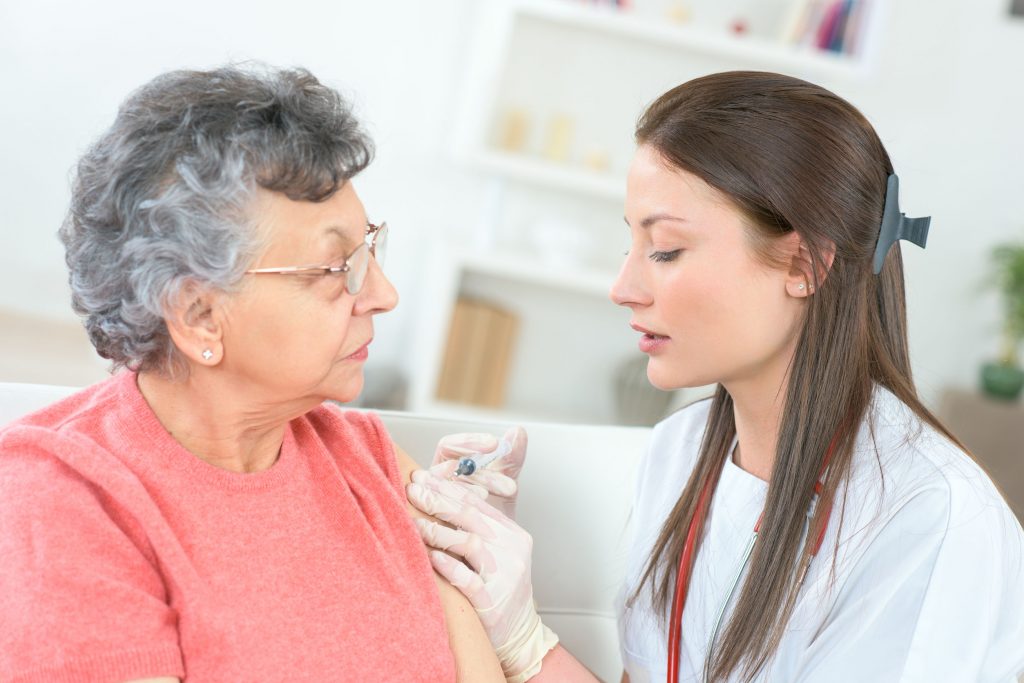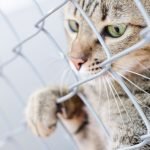Docere
Alethea Fleming, ND
Routine non-annual vaccinations for patients over the age of 65 include a single-dose shingles vaccine and a 2-part pneumonia vaccine. If you see seniors as part of your practice, it is useful to be familiar with these immunizations so that you can provide guidance and information to them.
Incidence of Shingles & Pneumonia
Shingles is a reawakening of the herpes zoster virus that lays dormant in the basal nerve ganglia after childhood exposure to chickenpox. The risk of experiencing shingles is 0.5-1.0% for people under the age of 60, and as high as 1% above age 80.1 While individual risk is low, shingles still affects a large number of people. In less than 5% of all patients with shingles, a secondary complication called post-herpetic neuralgia (PHN) arises, which is potentially debilitating pain that lingers after the rash has cleared. Preventing PHN is the primary goal of shingles vaccination.
Pneumonia is a common infection (secondary and primary) in older adults, and is particularly lethal in patients over the age of 80 who are likely to die, even with intensive treatment. The pneumonia immunization protects against Streptococcus pneumoniae. This bacteria has 90 known serotypes, but most live quietly in humans without causing disease. Some forms of this bacteria can cause sepsis or meningitis in certain cases (invasive pneumococcal disease, or IPD), but most commonly cause bacterial pneumonia. Community acquired pneumonia (CAP) is caused by Streptococcus pneumoniae 24-40% of the time, and causes close to 400 000 hospitalizations annually in the United States; at least 5% of those hospitalizations result in death.2 One of the most concerning aspects of these infections is that they can come on very rapidly, which is partly why vaccination is recommended.
Vaccine Background
In 2006 Merck released Zostavax, the herpes zoster vaccination that protects against shingles; it is the only shingles vaccine currently available worldwide. Zostavax is most often recommended for patients over the age of 60, but is approved for ages 50-59 as well. The goal is to use it in the population that is hardest hit by the disease, hence the general recommendation for patients over 60, who are more statistically likely to experience shingles. Long-term efficacy of this vaccine is still unknown.
The first pneumococcal vaccine was introduced in 1977. Currently, 2 vaccinations are used: pneumococcal polysaccharide vaccine (PPSV23) and pneumococcal conjugate vaccine (PCV13). It wasn’t until 2014 that the Centers for Disease Control and Prevention (CDC)’s Advisory Committee on Immunization Practices (ACIP) recommended routine vaccination with PCV13 for all adults over the age of 65.2 In September of 2015 they broadened the recommendation to include a dose of PPSV23, administered 1 year after the PCV13, to cover a broader spectrum of serotypes. If a patient has received a dose of PCV13 prior to age 65, then it does not need to be repeated; however, administering a dose of PPSV23 is recommended. If both have been given prior to age 65, then a second dose of PPSV23 is recommended after turning 65, assuming it has been at least 5 years since receiving the last dose. The reason the PCV13 is administered first, despite PPSV23 having a larger number of protective strains, is that patients have a better immune response with this sequence than when vaccinated only with the PPSV23. PCV13 works via T-cell activation, which lasts longer than the B-cell activation induced by PPSV23. If a patient has had pneumococcal disease, the vaccine doesn’t necessarily protect them from future infection because of the large number of Streptococcus pneumoniae serotypes.
The ACIP will revisit this recommendation in 20183 and in the meantime will be monitoring efficacy of the new recommendation. There is some potential to reduce the number of pneumococcal vaccines recommended for seniors in the future due to the herd immunity effect, ie, successful reduction of pneumococcal disease outbreaks in children through routine vaccination.
Efficacy & Indications
The CDC states that use of the Zostavax vaccine reduces the risk of developing shingles by 51%, and of developing PHN by 67%. This statement is based on the Shingles Prevention Study,4 a large study that followed close to 40 000 patients for 3.1 years (median). A second study5 followed a subset of these patients (approximately 14 000) for an additional 4-7 years (and a further small subset for even longer), which allowed the CDC to conclude that efficacy after 5 years in the population for which the vaccine is most indicated (above age 60) is not reliable. Note that data for patients above age 80 is minimal.
Immune compromise increases risk of herpes zoster. Compared to the general population, risk of shingles is twice as high for cancer patients with solid tumors and nearly 6 times as high for patients with hematological cancers.6 Unfortunately, patients with hematological cancers or HIV are not eligible for live virus vaccines. Some people worry about whether they should get the vaccine after they’ve had an outbreak. For robust or normal immune systems, the data is not compelling to vaccinate after 1 outbreak of zoster,7 as the likelihood of recurrence is low. In fact, there is an increase in humoral response after having shingles, which confers immunity similar to, if not better than, the vaccine. Consequently, the current recommendation is to wait a year after having had an outbreak of shingles before considering getting the vaccine,8 so that maximal immune response is achieved.
Another common question is whether booster shots should simply be administered at 5-10 year intervals, but it’s not yet clear if the immune system would actually benefit further from this or not. There is a clinical trial (sponsored by Merck) currently underway examining that question, with a booster administered 10 years after initial vaccination (ClinicalTrials.gov #NCT01245751). The trial is complete, but data have not yet been published.
Efficacy of the pneumococcal vaccines is good for the strains that they cover: For adults over the age of 65, the PCV13 vaccine is 75% effective against invasive pneumococcal disease (meningitis and sepsis) and 45% effective against pneumococcal pneumonia.3 The PPSV23 is at least 50% effective against invasive pneumococcal disease.3 Boosters after the initial vaccinations are not currently recommended. Like all vaccines, immune response wanes with age, so even though it helps, the protection conferred isn’t as strong for adults as it is for children.
Risks of Vaccination
The shingles vaccine is contraindicated for anyone who has an allergy to any ingredient in the vaccine (including gelatin and neomycin, an antibiotic), anyone with reduced immunity such as cancer patients undergoing chemotherapy or radiation treatment, pregnant women, patients using steroid drugs, or patients with immune deficiency diseases such as HIV/AIDS. Zostavax is a live virus vaccine. Common side effects include soreness, redness, swelling or itching at vaccination site, and headache.2 A new subunit (non-live virus) vaccine is being studied that looks promising for greater immune response, even in immunocompromised patients; this vaccine is still in the development and testing phase.
The pneumococcal vaccines should not be given to anyone who has an allergy to any of the vaccine ingredients such as aluminum or polysorbate 80. Both vaccines are inactivated virus and cannot cause infection with pneumonia. Less than 1% of all patients receiving the vaccines have mild side effects such as slight fever and/or soreness at the site of administration.2
Discussion
A critical factor when discussing vaccination in older patients is that the older a patient is, the more vulnerable he or she is to disease and secondary effects (such as PNH); older patients need guidance on immunizations specific to their age group. At the same time, however, increasing age also decreases efficacy of vaccination, and at some point those 2 vectors cross and render routine immunization less effective. For now, what we know about the shingles vaccine is that it does decrease incidence of shingles and post-herpetic neuralgia for at least 5 years in older adults, but that most people’s risk is low to begin with. For patients over the age of 65 who live, work, or socialize in environments where they are potentially exposed to pneumococcus (eg, retirement communities or skilled nursing facilities), vaccination is recommended.
Particularly when discussing shingles, educate patients that non-pharmaceutical treatment is available and is often quite effective at decreasing length of the outbreak and severity of symptoms; sadly, this does not come up in any of the research cited in this article. Pneumonia can be successfully treated by a wide variety of therapeutics – naturopathic and allopathic – as long as it is recognized early.

Alethea Fleming, ND, is a passionate advocate for naturopathic geriatric medicine. She is a 2007 Bastyr University graduate, as well as a member of WANP, AANP, and OncANP. Dr Fleming is the owner and lead physician of the Vital Aging Clinic in Anacortes, WA, providing primary and adjunctive care. She is an engaging public speaker who strives to make naturopathic geriatric care accessible to all providers. In her off hours, Dr Fleming can be found hiking the trails of Fidalgo Island, spending time with her family, or with her nose firmly in a good book.
REFERENCES:
- Kawai K, Gebremeskel BG, Acosta Systematic review of incidence and complications of herpes zoster: towards a global perspective. BMJ Open. 2014;4(6):e004833.
- Centers for Disease Control and Prevention. Hamborsky J, Kroger A, Wolfe C, eds. Epidemiology and Prevention of Vaccine-Preventable Diseases. 12th ed. Washington, DC: Public Health Foundation; 2012. Available at: http://www.cdc.gov/vaccines/pubs/pinkbook/chapters.html. Accessed June 15, 2016.
- van Werkhoven CH, Bonten MJ. The Community Acquired Pneumonia Immunization Trial in Adults (CAPiTA): what is the future of pneumococcol conjugate vaccination in elderly? Future Microbiol. 2015;10(9):1405-1413.
- Schmader KE, Oxman MN, Levin MJ, et al. Persistence of the efficacy of zoster vaccine in the shingles prevention study and the short-term persistence substudy. Clin Infect Dis. 2012;55(10):1320-1328.
- Lal H, Cunningham AL, Godeaux O, et al. Efficacy of an adjuvanted herpes zoster subunit vaccine in older adults. N Engl J Med. 2015;372(22):2087-2096.
- Habel LA, Ray GT, Silverberg MJ, et al. The epidemiology of herpes zoster in patients with newly diagnosed cancer. Cancer Epidemiol Biomarkers Prev. 2013;22(1):82-90.
- Tseng HF, Chi M, Smith N, et al. Herpes zoster vaccine and the incidence of recurrent herpes zoster in an immunocompetent elderly population. J Infect Dis. 2012;206(2):190-196.
- Van Epps, P, Schmader KE, Canaday DH. Herpes Zoster Vaccination: Controversies and Common Clinical Questions. Gerontology. 2016;62(2):150-154.




